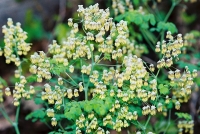Description
Early meadowrue, Thalictrum dioicum, grows up to 2 1/2' tall and wide. It's pale green to purplish stems are round (terete), smooth (glabrous) and look like they have a white powdery coating (they're glaucous). Meadowrue leaves are arranged alternately on the stem and are doubly or triply compound. That is, the leaf is divided into segments once and then the segments are further divided into leaflets. The entire leaf is up to 1' long and wide and the leaflets are about 1 1/2". The upper surface of the leaves is medium green while the undersides are pale green.
Branched flower structures (corymbs) form at the tops of the main stems and hold pendant flowers. Unlike many plants which have bisexual (monecious) flowers with both male and female parts, early meadow rue flowers are either male or female and found on seperate male and female plants (they're dioecious, hence the species name dioicum). Both male and female flowers have 5 to 7 green sepals but lack petals since they are wind pollinated and do not need to attract insects. Male flowers are pendant and have 10 or more yellow stemans while females are held upright and have about 20 pistils. Fertilized female flowers produce fruits (seeds) called achenes which are ellipse shaped, ribbed, and pointed at each end.
Early meadowrue is ephemeral, actively growing and flowering in the spring before the trees leaf out and block the sunlight and then dying down for the summer. The plants may produce a few fresh low leaves in the fall but then go dormant again until the following spring.
The root system consists of slowly creeping rhizomes with fibrous roots attatched.
Distribution
Found in the eastern half of Canada and the United States, early meadowrue extends from North Dakota to Maine in the northern United States and from Arkansas to Georgia in the South.
Habitat and Cultivation
Early meadowrue prefers to grow in ravines, on clay or loam wooded slopes, and in rich mesic (neither too wet nor too dry) woodlands. It is common in forests with a lot of sugar maple and basswood. In cultivation, early meadowrue grows well in moist garden soil in a shaded spot that gets plenty of sunshine in the spring before the trees leaf out. Because the plants often go dormant by mid summer the thoughtful gardener will want to keep track of where the dormant roots are so she or he doesn't accidently dig them up or damage them.
Wildlife Value
Because they are pollinated by the wind early meadowrue do not produce showy flowers or nectar and are not of interest to pollinators. Rabbit and deer browse the leaves which are also the food for the larvae of up to four different species of moths.
Conservation Status
All of Wisconsin's plants are given 0 to 10 "coefficient of conservatism" which rates them in terms of their sensitivity to ecological disturbance with 0 being the least sensitive and 10 the most. The rating system is part of something called the Wisconsin Floristic Quality Assesment (WFQA). http://www.botany.wisc.edu/herbarium/wisflora/WFQA.html Early meadowrue is not listed as a special concern, threatened, or endangered and can still be seen in older woods around Wisconsin but it has been assigned a coeffecient of conservatism of 7 which means that it will not fair well if it's habitat continues to be disturbed or destroyed.





